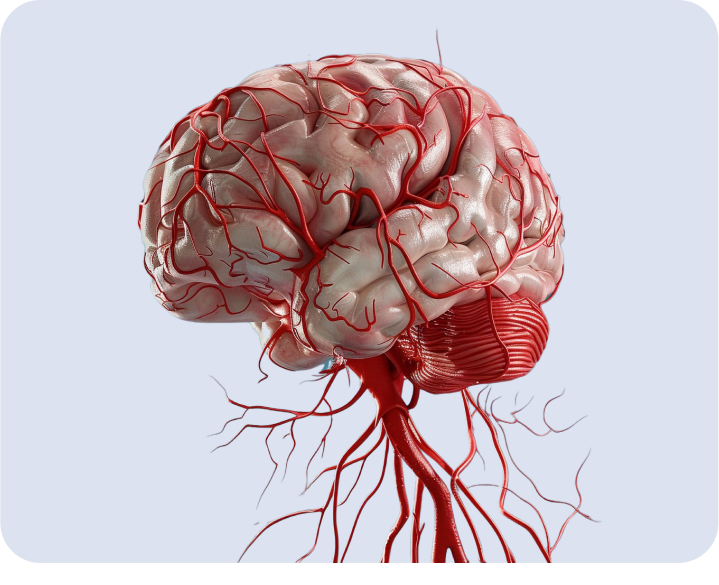Neurology - Page 3
Registered on ClinicalTrials
Features of response to the stress of elderly men and women with chronic brain ischemia
Authors:
Slyusar T.A., Abramenko Yu.V., Rubin S.S., Mayorov R.V., Slyusar I.N.
FSBEI in the Tver State Medical University of the Ministry of Health of Russia, Tver
Clinical effectiveness of antioxidant therapy with Mexidol Fort 250 patients with chronic cerebral venous deficiency
Authors:
E.I. Chukanova, A.S. Chukanova, H.I. Mamaeva
FGAOU in Russian National Research Medical University named after N.I. Pirogov »Ministry of Health of Russia, Moscow, Russia
The influence of Mexidol on the quality of life and the functional status of patients with chronic ischemia of the brain and chronic heart failure with a low emission fraction
Authors:
V.V. Tolkacheva 1 , E.R. Kazamedov 1 , railway Kobalava 1 , S.A Galochkin 1 , A.V. Schulkin 2
1 FGAOU in Russian University of Friendship of Peoples, Moscow, Russia;
2 FSBEI in the Ryazan State Medical University named after Acad. I.P. Pavlova "of the Ministry of Health of Russia, Ryazan, Russia
The effectiveness and safety of the use of ethylmethylhydroxypyridine of succinate in the framework of sequential therapy in patients with chronic brain ischemia
Author:
V.V. Burdakov, D.V. Red
FSBEI in Orenburg State Medical University of the Ministry of Health of Russia, Orenburg, Russia
The effectiveness and safety of the use of ethylmethylhydroxypyridine of succinate in patients with acute ischemic stroke
Authors:
M.V. Zhuravleva 1.2 , I.A. Schukin 3 , M.S. Fidler 3 , A.B. Prokofiev 1.2 , S.Yu. Serebrova 1.2 , N.S. Vasyukova 4 , E.Yu. Demchenkova 1 , V.V. Arkhipov 1
The effectiveness and safety of Mexidol in patients of different age groups in the acute and early recovery periods of the hemisphere ischemic stroke (the results of subanarized a randomized double blind multicenter placebo-controlled in parallel groups of the study of epic)
L.V. Stakhovskaya 1 , E.A. Mkhitaryan 2 , O.N. Tkachev 1.2 , T.M. Ostroumova 3 , O.D. Ostroumova 3.4
1 FGAOU in Russian National Research Medical University named after N.I. Pirogov »Ministry of Health of Russia, Moscow, Russia;
2 Russian Gerontological Scientific and Clinical Center of the FGAOU in the Russian National Research Medical University named after N.I. Pirogov »Ministry of Health of Russia, Moscow, Russia;
3 FGAOU in the First Moscow State Medical University named after THEM. Sechenov »Ministry of Health of Russia (Sechenov University), Moscow, Russia;
4 FSBEI of DPO “Russian Medical Academy of Continuing Professional Education” of the Ministry of Health of Russia, Moscow, Russia
Place of publication:
a journal of neurology and psychiatry named after S.S. Korsakova, 2020, T.120, No. 8, Issue 2
The effectiveness of the use of ethylmethylhydroxypyridine of succinate in patients with cerebrovascular pathology against the background of diabetes and metabolic syndrome
Authors:
E.V. Ekusheva 1.2 , E.V. Biryukova 3
1 FSBI “Academy of post-sex education“ Federal Scientific and Clinical Center for Specialized Medical Assistance and Medical Technologies of the Federal Medical and Biological Agency ”, Moscow, Russia;
2 FGAOU Belgorod State National Research University, Belgorod, Russia;
3 FSBEI in the Moscow State Medical and Dome University named after A.I. Evdokimova »Ministry of Health of Russia, Moscow, Russia
The effectiveness and safety of the drug Mexol Forte 250 with sequential therapy of patients with chronic brain ischemia
Authors:
N.G. Kataeva 1 , T.A. Zamoshchina 1.2 , M.V. Svetlik 1.2
1 FSBEI in Siberian State Medical University Mini Health of Russia, Tomsk, Russia;
2 FGAOU in National Research Tomsk State University, Tomsk, Russia
Study of the effectiveness and safety of the drug Mexol Fort 250 as part of consecutive therapy in patients with a hemisphere ischemic stroke in acute and early recovery periods
Authors:
M.A. Loskutnikov, M.A. Domashenko, T.M. Vakin, I.A. Trushina, V.I. Konstantinov, O.S. Proskuryakova, E.P. Schukina
Elderly patient with cerebrovascular pathology: Features of examination and conduct
Authors:
E.V. Ekusheva, E.A. Mkhitaryan
The role of oxidant stress in the development of vascular cognitive disorders
Author:
A.N. Bogolepova
FGAOU in Russian National Research Medical University named after N.I. Pirogov »Ministry of Health of Russia, Moscow, Russia;
FSBI "Federal Center for Brain and Neurotechnology" FMBA of Russia, Moscow, Russia
The effectiveness and safety of the use of ethylmethylhydroxypyridine of succinate in patients with chronic brain ischemia
Authors:
M.V. Zhuravlev 1.2 , A.B. Prokofiev 1.2 , S.Yu. Serebrova 1.2 , N.S. Vasyukova 3 , E.Yu. Demchenkova 1 , V.V. Arkhipov 1
1 FSBI “Scientific Center for Expertise of Medical Application” of the Ministry of Health of Russia, Moscow, Russia;
2 FGAOU VO "First Moscow State Medical University named after THEM. Sechenov »Ministry of Health of Russia (Sechenov University), Moscow, Russia;
3 FGBNU “Federal Scientific Center-All-Russian Research Institute of Experimental Veterinary Medicine named after K.I. Scriabin and Ya.R. Kovalenko of the Russian Academy of Sciences ", Moscow, Russia
The effectiveness of the use of ethylmethylhydroxypyridine of succinate in the restoration treatment of patients who have undergone ischemic stroke
Authors:
M.V. Zhuravlev 1.2 , A.B. Prokofiev 1.2 , V.V. Arkhipov 1 , S.Yu. Serebrova 1.2 , G.I. Gorodetskaya 1.2 , O.A. Demidova 1
1 FSBI “Scientific Center for Expertise of Medical Application” of the Ministry of Health of Russia, Moscow, Russia;
2 FGAOU VO "First Moscow State Medical University named after THEM. Sechenov "Ministry of Health of Russia (Sechenov University), Moscow, Russia
The effectiveness and safety of the drug Mexidol Fort 250 in the framework of prolonged consistent therapy in patients with ischemic stroke in a carotide pool
Authors:
I.A. Strelnikova 1 , A.A. Svetkina 1.2 , O.V. Androfagin 1
1 GBUZ "Samara Regional Clinical Hospital named after V.D. Seredavina "of the Ministry of Health of the Samara Region, Samara, Russia;
2 FSBEI in Samara State Medical University of the Ministry of Health of Russia, Samara, Russia
The results of the sequential use of Mexidol and Mexidol Forte 250 in patients with chronic brain ischemia
Author:
Yu.V. Abramenko
FSBEI in the Tver State Medical University of the Ministry of Health of Russia, Tver, Russia
The modern concept of cognitive reserve
Author:
Koberta N.N., Tabeeva G.R.
Place of publication:
NEUROLOGY. NEUROPSYCHIATRY. Psychosomatics, 2019
THE INFORMATION IS INTENDED FOR HEALTHCARE AND PHARMACEUTICAL PROFESSIONALS. THIS INFORMATION IS NOT INTENDED AS A SUBSTITUTE FOR MEDICAL ADVICE.
Source of photos and images Shutterstock.com














